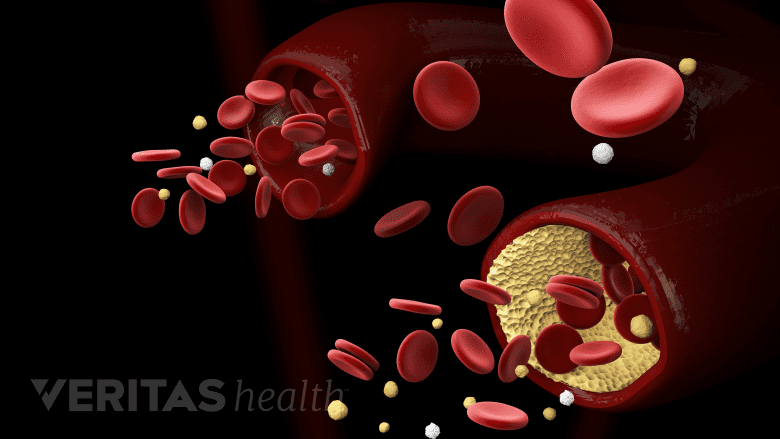A single, underlying cause for abdominal aortic aneurysms is unknown. Many known factors may lead to an abdominal aortic aneurysm developing: cardiovascular problems, genetic conditions, family history, and lifestyle and health habits.
In This Article:
- Abdominal Aortic Aneurysm
- Abdominal Aortic Aneurysm Symptoms
- Abdominal Aortic Aneurysm Causes
- Abdominal Aortic Aneurysm Treatment
Common Causes of Abdominal Aortic Aneurysm

Cholesterol build-up may contribute to the development of abdominal aortic aneurysms.
The conditions associated with a heightened risk for abdominal aortic aneurysm include the following:
- Atherosclerosis. This condition occurs when plaque buildup in the bloodstream causes the body’s blood vessels to harden and narrow. Atherosclerosis may develop during young adulthood but only becomes problematic later in life.
- High cholesterol. Cholesterol may build up in the blood vessels, which can narrow the bloodstream and harden the arterial walls.
- High blood pressure. A sustained increased force of blood moving through the aorta can weaken the artery walls. High blood pressure is a common condition that is most prevalent in those who smoke cigarettes, people who are overweight, and older adults. An estimated 65% of people over age 60 have high blood pressure.1Risk Factors for High Blood Pressure. National Heart, Lung, and Blood Institute. National Institutes of Health. http://www.nhlbi.nih.gov/health/health-topics/topics/hbp/atrisk. Updated September 10, 2015. Accessed October 2016.
- Inflamed arteries. Inflammation can constrict blood flow and cause the arterial walls to weaken, increasing the risk of an aneurysm. Arteries may become inflamed by trauma to the abdomen, disease (such as vasculitis), genetic predisposition, and conditions such as atherosclerosis and high cholesterol.
- Connective tissue disorders. Hereditary conditions that weaken the body’s connective tissues can lead to degeneration of the aortic walls and raise a person’s risk for aneurysm. Two of the most common connective tissue disorders are Ehlers-Danlos syndrome, a group of conditions that affect collagen production, and Marfan Syndrome, which increases the production of the protein fibrillin.
Risk Factors For Abdominal Aortic Aneurysm

Smoking damages and weakens the blood vessels.
Some health and lifestyle factors put additional strain on the cardiovascular system and increase the risk of weakened or damaged blood vessels, raising the chance an abdominal aortic aneurysm will develop. Such risk factors include:
- Smoking and tobacco oral use is one of the biggest contributors to diminished cardiovascular health. People with a history of smoking are 3 to 5 times more likely to develop an abdominal aortic aneurysm.2Your Aorta: The Pulse of Life. American Heart Association. http://www.heart.org/HEARTORG/Conditions/VascularHealth/AorticAneurysm/Your-Aorta-The-Pulse-of-Life_UCM_475411_Article.jsp#.WHZK0VMrJhE. Updated September 26, 2016. Accessed October 15, 2016.
- Advanced age. Aneurysm is most common in older adults who are more predisposed to cardiovascular problems and are more likely to have higher levels of plaque buildup in the arteries.
- Genetics and family history. Between 12% and 19% of immediate relatives of a patient with an abdominal aortic aneurysm will also develop the condition.3van Vlijmen-van Keulen CN, Pals G, Rauwerda JA. Familiar abdominal aortic aneurysm. Eur J Vasc Endovasc Surg 2002;24:105-16 as cited in Upchurch Jr GR, Schaub TA. Abdominal Aortic Aneurysm. American Family Physician website. Accessed October 21, 2016.
- Physical activity level. Not receiving adequate exercise puts a person at a higher risk for heart and cardiovascular disease. Regular aerobic exercise increases the heart rate and blood flow through the body, keeping tissues and blood vessels strong.
- Gender. Two-thirds of those affected by abdominal aortic aneurysms are men, and men are more likely to experience heart and cardiovascular problems in general.4Aggarwal S, Qamar A, Sharma V, Sharma A. Abdominal aortic aneurysm: A comprehensive review. Experimental & Clinical Cardiology. 2011;16(1):11-15.
While the above factors contribute to an increased likelihood of developing an abdominal aortic aneurysm, people who have not known risk factors may also develop the condition.
Treatment strategies for abdominal aortic aneurysm are not dependent on the cause of aneurysm, but rather on its size and risk for complications. Treatments may range from regular monitoring and lifestyle changes to urgent or emergency surgery.
- 1 Risk Factors for High Blood Pressure. National Heart, Lung, and Blood Institute. National Institutes of Health. http://www.nhlbi.nih.gov/health/health-topics/topics/hbp/atrisk. Updated September 10, 2015. Accessed October 2016.
- 2 Your Aorta: The Pulse of Life. American Heart Association. http://www.heart.org/HEARTORG/Conditions/VascularHealth/AorticAneurysm/Your-Aorta-The-Pulse-of-Life_UCM_475411_Article.jsp#.WHZK0VMrJhE. Updated September 26, 2016. Accessed October 15, 2016.
- 3 van Vlijmen-van Keulen CN, Pals G, Rauwerda JA. Familiar abdominal aortic aneurysm. Eur J Vasc Endovasc Surg 2002;24:105-16 as cited in Upchurch Jr GR, Schaub TA. Abdominal Aortic Aneurysm. American Family Physician website. Accessed October 21, 2016.
- 4 Aggarwal S, Qamar A, Sharma V, Sharma A. Abdominal aortic aneurysm: A comprehensive review. Experimental & Clinical Cardiology. 2011;16(1):11-15.

